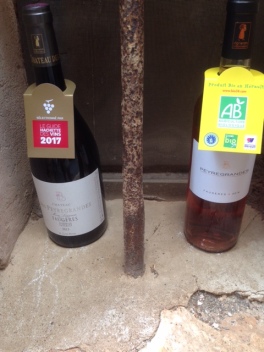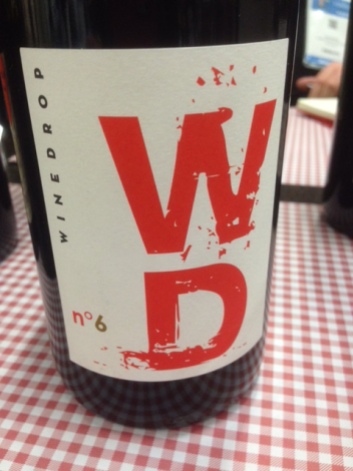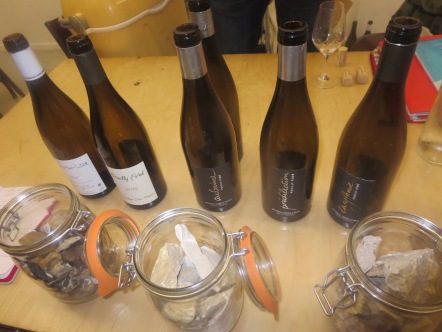
The annual wine event in the village of Faugères took place last weekend and I duly went along on Sunday for the tasting. Twenty five vignerons with stands along the streets and corners of the medieval village, all sharing their finest products, what is not to like? I have said many times before on these pages that Faugères is my favourite appellation in the region. The schist based vines produce deep flavours and a final twist of refreshment which leaves you wanting to taste more of the wine. I am looking for clean fruit, depth and compexity and that enjoyable palate cleansing finish.
Some of my favourite domaines were not present at the event, Barral, Clos Fantine, Domaine des Capitelles but that meant the opportunity to try other domaines as well as reacquainting myself with other favourites. * Rosemary George was present signing copies of her authoritative book on Faugères and asked me whether I had discovered anything new, happily I had.
* (plus Mas Sibert based in Fos but whose wines are more Pézenas and not strictly appellation wines either)

Domaine De L’Ancienne Mercerie is one I have tasted previously and is a firm favourite of my friend Graham Tigg whose palate I trust implicitly. These wines wee certainly on good form today; a refeshing Blanc 16, a big oaky Couture 13 but best for me was the Petites Mains 15. This is a classic Faugères full of long flavours of dark fruits with an earthy note and that lick of acidity to cleanse the mouth. An assemblage of Carignan, Syrah, Grenache and Mourvèdre Petites Mains would be a excellent introduction to the Languedoc and to Faugères. Website
Chateau Des Peyregrandes is based in Roquessels. With 25ha this is a large domaine and there were multiple bottles on taste. These ranged from a good Blanc 16 to big oaky reds. Personally two wines stood out for me. The Rosé 16 was much darker than many rosés, the Syrah had given it colour. Nice red fruits and a long textured finish, this would be a good aperitif or match many foods. I also liked Prestige 13 with good character and complexity from Syrah, Carignan and Mourvèdre. Website
Domaine Valambelle was new to me though it is a well established, independent producer in Laurens since 2002. Another large domaine with many cuvées I tried a handful. Millepeyres 15 offered a classic Carignan with red fruits, an earthiness too. I also liked the Mourvèdre led Caprice 15 (well named for this grape) with plummy fruits. Keenly priced, good wines. Website
Domaine Du Causse Noir is the Cabrerolles domaine of Jérome Py and he always greets me with a big smile and firm handshake. His wines are regulars on my table and firm favourites, indeed I had opened a bottle two nights before. It was good to meet this great guy again and share his wines with some Arbroath converts who were at the stand at the same time. Low yields of 20-25 hl/ha give a rich full bodied fruit profile in the cuvées. 3,14 (a pun on π) 2015 is so complex for an entry wine, full of fruit and life. Caius 14 was even fresher and Mathias 13, serious and lovely. Favourites again. Website
Jérome Rateau makes wines under his own name as well as his domaine Haut Lignières. Based at the top of the village of Faugères Jérome’s wines are always good. New to me this year was a premium white Empreinte Carbone (same name as the prestige red). Made with the same juice as the Petites Plumes white but given 9 months in a very lightly charred new barrel with acacia top and bottom. The effect was certainly impressive, very little oak flavour surprisingly but lots of nutty complexity. Website
Domaine De Cébène was one of the first Languedoc domaines I visited and remains a favourite. Brigitte Chevalier has made a name for herself and her wines through hard work and skill, she has lovely vines high on the hills around Caussiniojouls along with a brand new chai. Brigitte showed the wines of her partner who makes St. Martin D’Agel whose traditional red I like very much. Brigitte was showing the excellent Carignan Belle Lurette 15 with fruit, complexity and a long life ahead. She explained that the schist soils mean the vines send out very long roots to fins nourishment and their contact with the soils adds complexity. My personal favourite of the Cébène wines is Les Bancels, classic combination of Grenache, Syrah and Mourvèdre. The 14 was expressive, round with full fruits and the classic Faugères refreshing finish. Brigitte kindly opened a 15 to compare, and it will be great. Still a little reticent it packs flavour and, yes, that finish. Website
Mas Angel / La Graine Sauvage is the domaine of Alexandre Durand and Sybil Baldassarre also based in Caussiniojouls. Sybil is, first and foremost, an oenologue and I have been privileged to meet her and Alexandre numerous times at Mas Coutelou and various events. They have ventured into winemaking for themselves and the results are impressive. The white Rocalhas was star of the day. Grenache Blanc, Roussanne and Marsanne grapes blended to give a gorgeous fruit nose with soft, peachy fruit and a nice sharp finish. Very drinkable, very good. A lovely red fruits and textured Prestige 15 red (Carignan/Grenache) and very deep, complex Syrah Marius 15 converted me completely. These are very good Faugères wines, very good natural wines. If you want proof that natural wines can express terroir then here you are. Facebook
A very enjoyable morning, lots of parades, stalls, music and fun. But most of all, a reminder that Faugères is so good. Incidentally all of these domaines are organic, other than Haut Lignières, this really is a pioneering appellation.


























































































